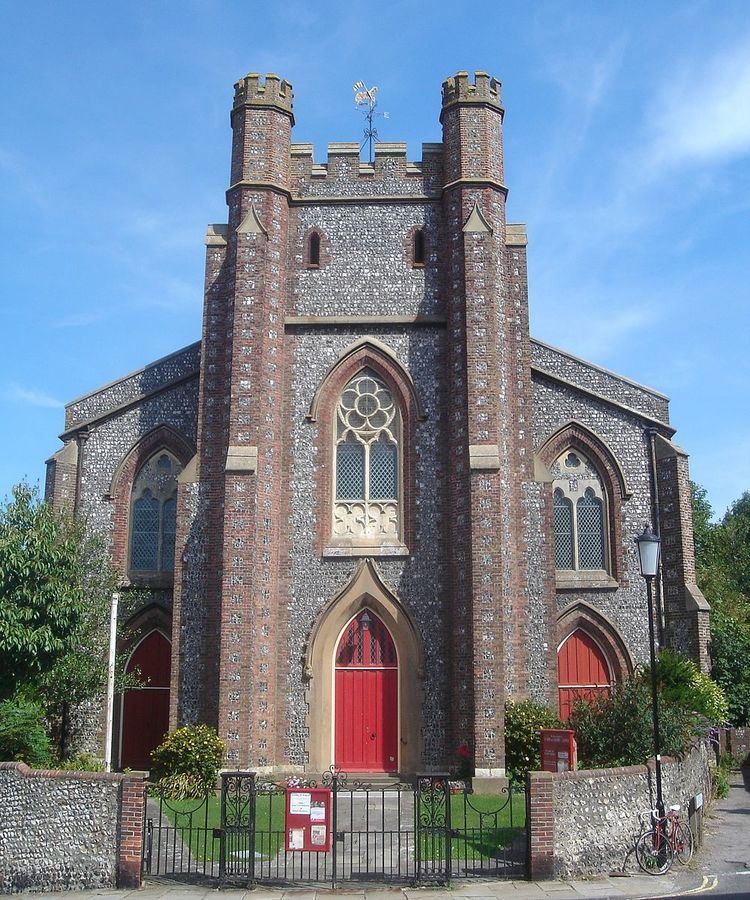OS grid reference TQ 4146 1040 Consecrated 3 June 1840 Opened 1839 Status Parish church | Country England Phone +44 1273 473080 | |
 | ||
Architectural style Gothic Revival architecture Similar Lewes Castle, Lewes Free Presbyter, Lewes Priory, River Ouse - Sussex, Anne of Cleves House | ||
The Church of St John sub Castro is an Anglican church in Lewes, the county town of East Sussex, England (grid reference TQ 414 104). It was built in 1839 on the site of an 11th-century Saxon church, and has been designated by English Heritage as a Grade II listed building. In the churchyard is a memorial to Finnish prisoners from the Crimean War who died while confined in Lewes Naval Prison; the memorial is also listed Grade II. The church continues to be active as a parish church in the diocese of Chichester.
Contents
History
In the early 11th century, a church was built on the site of a Roman fort erected to guard a crossing over the Ouse, below which the river was navigable. The site was in the north-west corner of the walled town, on "the brink of an abrupt cliff of chalk", and contained two conical mounds, one of which was later found to contain remains of human burials. The church came into the possession of the Cluniac Priory of St Pancras in 1121, and the earliest known reference to its relation to Lewes Castle (Latin: sub castro), presumably to distinguish it from the priory chapel at Southover, also dedicated to St John the Baptist, dates from 1190. William Camden's Britannia of 1586 reported the building "all desolate and beset with briers and brambles". Around that time the chancel was demolished, and a major restoration in 1635 left the church comprising just nave and tower. In the early 19th century, there was significant housing development in the St John's area of the town. The church had only 260 seats, totally inadequate for a parish whose population had trebled over a 30-year period to more than 2,300 and continued to grow. Concluding that it was impractical to extend the old church, the rector, Peter Guerin Crofts the Younger, had it demolished and a new one built on the site. The 1851 religious census of Sussex reported the population of the parish at 2,485, and the average attendance at evening service at 800.
Structure
The new church was designed by George Cheesman in the Early English style, to include a rectangular aisled nave with no arcading, a short chancel, and a short embattled tower with castellated octagonal turrets, and constructed in knapped flint with red brick dressings. An apse was a later addition. Because of the limitations of the site, it was built on a north-south rather than the usual east-west orientation, and lies to the south of the original building. It has large lancet windows with what Nikolaus Pevsner describes as "ignorant" tracery, and (again according to Pevsner) a "good, solid barn roof with tie-beams". The tower, placed centrally at the ceremonial west end of the church, projects forward of the front wall, and contains three 18th-century bells by John Waylett, one of which was re-cast in 1886.
Though the local newspaper found the new construction "convenient and well-arranged", others were less impressed. Mark Antony Lower, founder of the Sussex Archaeological Society, called it a "modern brick structure, which we cannot commend, as it is a kind of hybrid between a castle and a barn", while the 1868 edition of Murray's Handbook for Travellers in Kent and Sussex was blunter, calling it "modern, and ugly".
Furniture and fittings
Internally, cast iron posts support galleries with painted panelled fronts which extend for the full length of the nave on each side. The ceiling is barrel-shaped, with pine trusses, and is painted orange and brown. The apse has stained glass windows designed by Henry Holiday and made by James Powell and Sons, and windows in the aisles include three produced by Savell in the latter part of the 19th century, and one by Walter Tower of Kempe & Co., dated 1910, which honours Prebendary Arthur Perfect.
The two-manual organ, built by Bishop in 1882 and rebuilt by Morgan & Smith of Brighton in 1927, stands in a chamber in the apse. When first opened, worshippers sat in box pews. Unusually for the time, more than half the seats in the church were free, i.e. no pew rents were charged, and many such free seats were in central positions in the nave. The box pews have since been replaced by open benches.
There are two fonts: a 15th-century octagonal bowl with arcading on three sides of the stem, in "battered" condition, and a quatrefoil-shaped bowl supported by marble shafts dating from the later 19th century. Above the main door is a large painting of Jesus blessing the children, which was painted in the workshop of Frans Floris in the 16th century, and above that are the royal coat of arms of George IV in iron. The parish registers exist from 1602.
Current activities
St John sub Castro continues to be active as an Anglican parish church in the diocese of Chichester, the archdeaconry of Brighton and Lewes and the deanery of Lewes and Seaford. It holds a modern, family-friendly morning service each Sunday, and services of Holy Communion and evening prayer once a month. It has hosted the town's annual Remembrance Sunday services. Musical concerts are held in the church.
The church was listed at Grade II by English Heritage on 16 March 1970. This status is given to buildings which are "nationally important and of special interest". As of February 2001, it was one of 1,162 Grade II listed buildings, and 1,250 listed buildings of all grades, in the district of Lewes.
